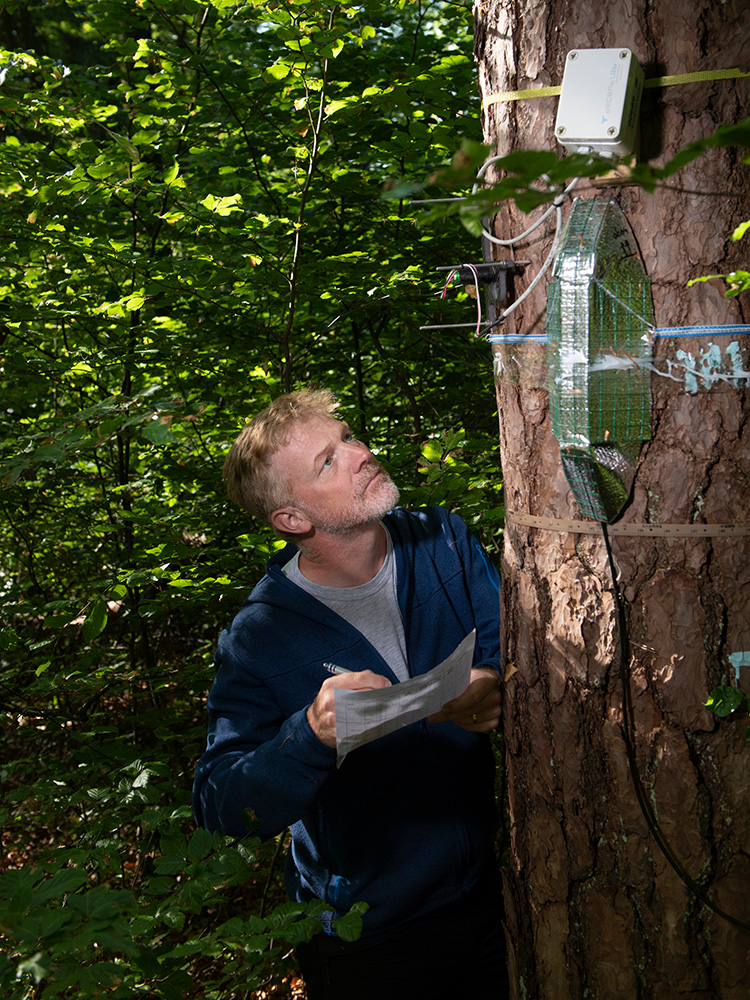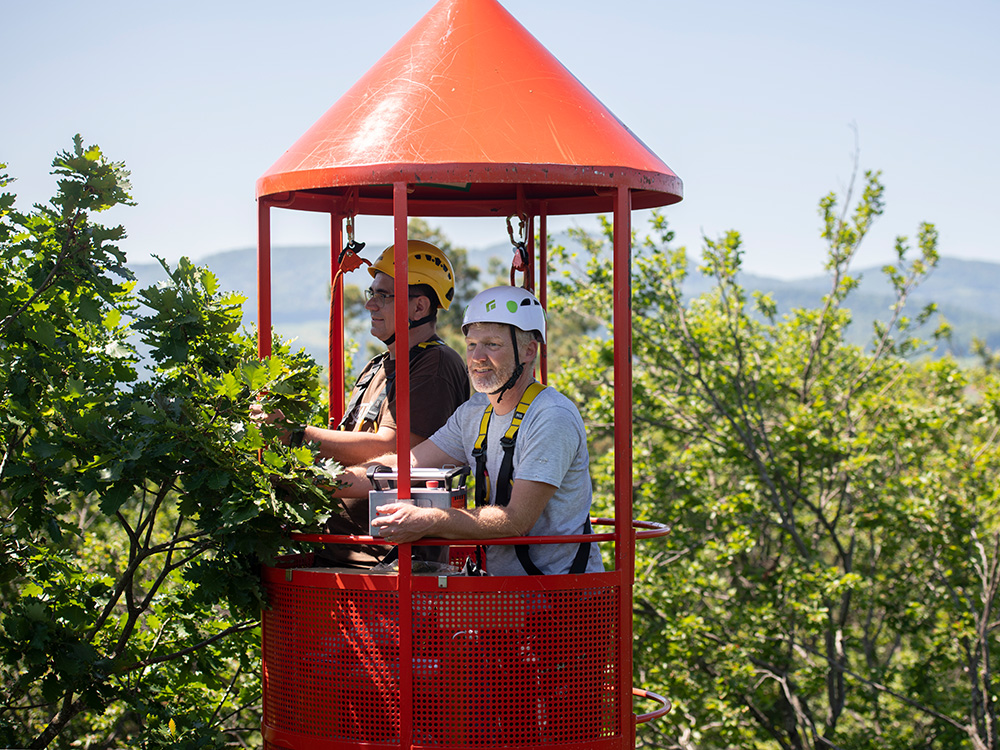How plants respond to global changes
Ansgar Kahmen, head of the Physiological Plant Ecology Group at the Department of Environmental Sciences at the University of Basel, is investigating how plants react to environmental changes and what consequences this has for us.
Plants play a critical role in maintaining the balance of the Earth’s ecosystem. Their capacity to release water into the atmosphere or to absorb CO2 from the air and incorporate it into organic compounds has a major influence on the Earth's climate and thus on the environment in which we live. Plants also stabilize the soil and serve as a food source for millions of other organisms, including humans, who could not exist without plants. But how do plants adapt and react to global changes, and what impact does this have on human welfare? These are the questions, Ansgar Kahmen is exploring in his research.
Forest roof project simulates climate change
To understand the effects of climate change or rising CO2 concentrations on vegetation, Kahmen is pursuing several different approaches. In one of them, he and his team are investigating the effects of specific experimental changes on environmental parameters. Exemplary for this approach is the large forest experiment in Hölstein BL. On an area of 1.6 ha, Kahmen and his team are investigating how reduced precipitation and the resulting drought in summer affects the Swiss forest. For this purpose, Kahmen's team has equipped up to 180 trees with sensors. They continuously record data on soil moisture, water supply and volume growth of trees, the swelling and shrinking of trunks in the day and night rhythm and the intensity of the incident sunlight are measured. An important component of the experiment is a 50-meter-high crane, which allows the researchers to make measurements and take leave samples almost anywhere within the tree crowns. After a setup and test phase of several years, the main experiment will begin in 2023. Roof-like structures under the treetops have been installed for the experiment that are covering an area of more than 3,000 m2 and shield the soil from about half the incoming precipitation.
Kahmen is particularly interested to find out how the various Swiss tree species react to drought, which species are particularly resistant and why species differ in their resistance. «Answering these questions is a prerequisite to plan the forests of the future with its important features and purposes for humans. Another key question is the adaptability of trees», Kahmen said.
It is well understood that many species react to a short-term water shortage by closing the stomata in their leaves so that less water evaporates from them. It is also conceivable that they develop less foliage in subsequent years so that the surface area over which water can evaporate becomes smaller – a phenomenon which has been observed in beech trees in the years following the hot summer of 2018. «We don't know, however, if and to what extent trees can adapt to a changing environment. But the answer to this question is central to understanding the forest's response to climate change.» Since the experiment in the Hölstein forest is planned to run for 20 years, Kahmen has a unique opportunity to experimentally answer this question.
Global Monitoring
Kahmen is very well connected with researchers in Switzerland and around the world. «The question of how forests as the world's most important carbon reservoir and the habitat of many other organisms react to climate change is not only of interest to us,» says Kahmen. Worldwide there are yet only a few comparable experiments like the one in Hölstein. «What we lack are long-term experiments in existing forests with old trees that teach us how climate change is affecting this ecosystem.» This is, however, not easy because trees are large and have long lifespans. The experimental manipulation of forests is thus a demanding task. An alternative is to document the response of trees or ecosystems to naturally occurring variability in temperature or water supply with the support of monitoring networks. At the Hölstein location, the water requirements of the trees and trunk growth are measured automatically on more than 80 trees using so-called dendrometers. As part of an international consortium, Kahmen and his team feed these data into national and international data networks. Analyses of large-scale data sets from these networks then make it possible to determine which species at which locations react particularly sensitively or particularly robustly to naturally occurring drought. Such analyses are essential. «Through international exchange, we generate a globally differentiated picture that maps well the response of different forest types to climate change» emphasizes Kahmen. This is the only way to generate models that can predict the global impacts of climate change and derive the resulting consequences for humans.
The past also provides insights
Experimental manipulations of plants or entire ecosystems are not the only approach Kahmen is using to study plant responses to global change. «Experiments in existing ecosystems, such as in the Hölstein forest, are logistically complex and cannot be carried out at will. In addition, such experiments always reflect artificial conditions and their results must be verified in nature.» For this reason, Kahmen and his team are also venturing back into the past. They examine plants from historical collections and compare them with modern samples. This allows Kahmen to determine whether plants in today's environment are different from plants that lived 100 or 200 years ago. Important sources for such historical samples are the Herbaria Basel. These collections contain more than 700,000 dried plants collected over the past 400 years. The founder of the Herbarium, which is one of the oldest continuous botanical collections in the world, was Caspar Bauhin (1560-1624), first professor of botany at the University of Basel.
Kahmen and his team are studying these plants using state-of-the-art methods, including the analysis of stable carbon and oxygen isotopes of the samples. Based on these data, they can assess for example whether the plants' water consumption has changed over the past centuries. «Plants lose significant amounts of water when they take up CO2 and have thus a major impact on the hydrology of ecosystems,» Kahmen says. «There is evidence that an increase in atmospheric CO2 concentrations corresponds with a decrease in the water consumption of plants.» In the coming years Kahmen wants to better understand this correlation and what this means for humans.
Future scenarios against heat and drought
Since 2018 Ansgar Kahmen leads a unique forest experiment in Europe, in which the effects of climate change for Central European forests are analyzed over a period of 20 years. In the Swiss Canopy Crane II project, a forest near Hölstein BL is being studied to see how water shortages affects different native tree species. The effects of extreme climate events on trees are only poorly understood The damage to the forest is yet obvious. «It is difficult to understand the mechanisms that cause damage to the trees and draw the right conclusions for the future», says Kahmen. «If we know the physiological mechanisms that make trees drought-resistant, we can begin to promote species that are be able to better cope with future climatic conditions».




